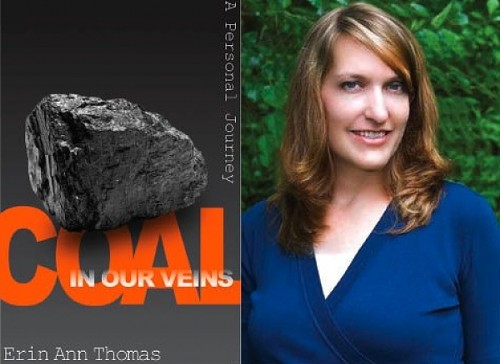Good writers can take a subject you weren’t previously interested in and not only entertain you while talking about it, but also make you want to know more. Such is the case with coal. It’s black. You burn it. Santa leaves you lumps of the stuff if you’ve been naughty. What more do you need—or more importantly, want—to know?
Plenty, it turns out, under the guidance of Erin Ann Thomas in Coal in Our Veins: A Personal Journey, as she transforms lumps of coal into a page-turner. You get a sense of what’s in store right from the start as Thomas spends the first nine pages of the book describing an early 20th-century carbide miner’s lamp. It could be dull and technical, but Thomas is able to weave the description in with the theme of her book and nearly 200 years of family history.
Even though you might not have thought much about coal, you, the average American, needs about 20 pounds of it burned per day to power your modern life. Any time you flip a light switch, charge your phone or play video games, there’s a 50/50 chance that coal is making it happen. Thomas takes as her theme a quote from George Orwell, who also wrote about coal and the people who haul it out of the earth: “We all know that we must have coal,” Orwell stated, “but we seldom or never remember what coal getting involves. ... We are capable of forgetting ... as we forget the blood in our veins.”
Thomas can’t forget, because for her, this isn’t just an issue of energy and the environment. It’s her family history, stretching back to 19th-century Wales, where her ancestors worked under horrendous conditions in the mines. They immigrated to America with big dreams, only to find themselves back underground in the mines of eastern Utah, where they were faced with two of the worst mining tragedies in American history. Thomas’ grandfather, Robert K. Thomas, worked his way out of the mines to become a BYU professor and eventually became president of the College of Eastern Utah, setting a future course for his family that would allow his granddaughter to have opportunities her ancestors never could have imagined, yet still feel a connection to those ancestors through coal.
“I cannot turn on the dishwasher, watch a movie, or write these words without thinking of coal,” Thomas writes. “And, conscious of this coal, I must think of the blood in my veins, because from the beginning of coal—this history of our energy—my ancestors pulled it from the earth with picks and with their hands.”
Thomas does a masterful job of mixing stories about people’s lives with statistics and discussions of government policies; she proves to be adept at family history, research, journalism and personal memoir. In a way, she has tried to weave together about five different books here—and she pulls it off, going from Wales to Utah to West Virginia to Washington, D.C.
Besides simply providing plenty of information, she also ties it into personal stories ranging from how her great-great grandfather, Evan Thomas, must have felt in Wales in 1854, when, as a 5-year-old, he rode piggyback on his father down into a mine shaft to help extract coal, to the author’s own asthma flare-ups when living near a coal-burning plant in the 21st century. She interviews bereaved families after a mine disaster, as well as coal-company publicists and protesters; she tours her fair share of underground tunnels.
Thomas is able to illustrate how destructive coal can be, yet also how abundant and addictive it is as an energy source. After all, something’s got to power the computer I’m writing this review on. It’s easier to just not think about it—and apparently I’m not alone. After a public hearing on a power plant near her home, Thomas comes to the conclusion that, for many people, “The coal-burning dilemma may be as simple as burning it somewhere else. ‘Somewhere else’ would inevitably fall on our less prosperous neighbors. ... ‘Burning it somewhere else’ is a solution that’s merely hiding the problem, ignoring the coal in our veins: a refusal to pay the actual price of our lifestyle.”
It’s harder to ignore the coal when she visits the Sago Baptist Church in West Virginia after the Sago Mine disaster of 2006, and finds a statue of Jesus with his hand on a miner—a statue carved out of coal. The experience leads to Thomas writing, “This black rock has had so much influence in shaping our modern world, but also in shaping mining communities and the people in them. Coal is much more than a job; it defines an entire culture.”
Thomas provides expert guidance in taking the reader from a piece of black rock to something that, literally and figuratively, “lies under people’s lives.”
ERIN ANN THOMAS:
COAL IN OUR VEINS: A PERSONAL JOURNEY
Release date: June 10, 2012
Utah State University Press
288 pages
$29.95 hardcover/$24 ebook
More by Geoff Griffin
-
A Family New Year
How to ring in 2020 with revelers of all ages.
- Dec 25, 2019
-
The 12 Arts of Christmas
A delightful dozen options for your holiday entertainment needs.
- Nov 27, 2019
-
Season Kickoff
A look at what's new, or old but great, at Utah's ski and snowboard resorts for the winter season.
- Nov 13, 2019
- More »



